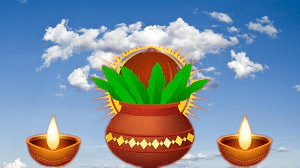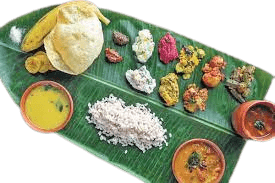The first day of the Chithirai month is celebrated as Puthandu by the people of Tamil Nadu. This day Celebrated as the Tamil New Year, holds a lot of importance and significance. This year in 2023, Puthandu will be celebrated on April 14. In 2024, Puthandu will be celebrated on 14th April on Sunday. In 2025 it will fall on 14th April on Monday.
Tamil New Year Puthandu
Puthandu, also known as Varsha Pirappu, is observed with a whole lot of grandeur and pomp by Tamilians all over the country. From decorating their homes to making pongal, they celebrate the new year with their loved ones. People look forward to celebrate the day with their families, friends and near and dear ones. Puthandu falls almost on the same day every year in the Gregorian calendar.
Puthandu (Puthu meaning ‘new’ + Andu meaning ‘year’) or Puthuvarusham (Puthu meaning ‘new’ and varusham meaning ‘year’) or Varusha Pirappu (Varusha meaning ‘year’ and pirappu meaning ‘birth’) is celebrated as the birth of a new year in Tamil Nadu.

As per the tradition and Tamil solar calendar, if the Sankranti happens after sunrise and before sunset, the day is considered as the New Year’s Day. If the Sankranti occurs after sunset, the next day is celebrated as Puthandu. Puthandu generally falls on April 14th or 15th every year.
Every New Year brings with it the promise of auspicious new beginnings. It is a time to make new plans and projects even as one bids goodbye to the old year. In Tamil Nadu, the New Year is called Puthandu, and it is celebrated as a festival in mid-April. To welcome the first day of the Tamil New Year or Vedic New Year, people take part in grand festivities and celebrations.
Tamil Puthandu falls on the first day of Chithirai month (mid-April- mid-May). It is usually celebrated on April 14. The New Year celebration takes place in other parts of India, too, as Vishu in Kerala and Baishakhi in northern and central India. Puthandu (Puthu meaning ‘new’ + Andu meaning ‘year’) or Puthuvarusham (Puthu meaning ‘new’ and varusham meaning ‘year’) or Varusha Pirappu (Varusha meaning ‘year’ and pirappu meaning ‘birth’) is celebrated as the birth of a new year in Tamil Nadu. It falls on the first day of the month, Chithirai, as per the Tamil solar calendar.
Tamilians greet each other on this special day in their lives by saying “Puthaaṇdu vaazhthugal! “, this means ‘Happy New Year!’

Puthandu Celebration
People make elaborate preparations for the Puthandu celebrations.
The first step is to clean the house thoroughly.
The second step is to decorate the house.
The third step is to prepare food items based on the concept of Arusuvai or a medley of tastes, including sweet, sour, salty, etc.
The day before the festival, people clean their houses and make them spick and span to mark a new beginning. This ritual of deep home cleaning on Tamil New Year’s eve is associated with the belief that one should get rid of the old to make room for the new. After cleaning the house, people also decorate it. They decorate the doorway with mango leaf thoranams (strings of freshly plucked mango leaves). Then they create colorful and intricate Kolams ( designs made of coloured rice flour at the entrance of the house ) or rangolis with rice flour, in front of the house.
Early in the morning on Puthandu day, Tamilians awake and take a bath. Some, especially in the rural areas, also have a herbal bath with some turmeric.
After the bath, the entire family wears new clothes that have been specially bought for the occasion. Doing so is also a way to mark new beginnings.
After wearing their new outfits, all the family members pray and make offerings to the gods. They may do Poojas, chant Mantras, and offer Arathi. Many also visit temples and pray for an auspicious and prosperous Tamil New Year.
The elders in the family offer money or presents to children and younger family members. The head priest or eldest family member reads out aloud the Panchangam, a Hindu calendar and almanac.
20 steps to How to celebrate Puthandu?
The Tamil New Year, known as Puthandu, is the first day of the Chithirai month and marks the beginning of the Tamil calendar. It is an auspicious occasion for celebrating the start of a new year and new possibilities. There are a number of things you can do, both the day before Puthandu and on the day itself, to ring in the new year and celebrate the new beginnings it promises.
1 – Making Preparations the Day Before Puthandu. Clean your home on the eve of Puthandu. Part of what is celebrated during the Tamil New Year is the possibility of new beginnings during the next year. As part of this celebration of new beginnings, start your festivities by cleaning and tidying your home in preparation for the new year. The entrances to the houses are decorated elaborately with kolams (design made with rice flower) and adorn the doorway with mango leaves.
2 – Some people choose to perform this housecleaning on Puthandu instead of the day before. Either practice is acceptable, though you will probably have more time for feasting and worshipping during the first day of the new year if you clean your home the day before.
3 – Gather foods of the six different tastes. Food preparation will happen the day of Puthandu, but you should gather the food you’ll prepare ahead of time. Follow the principle of arusuvai, the six different tastes found in Tamil cuisine: sweet, salty, bitter, sour, spicy (also known as “kaaram”) and a taste called “thuvarpu.” “Thuvarpu” is the taste of a common post-meal nut called the betel nut. It is also the taste of Indian gooseberry.

4 – In addition, you can also start preparing for festival dishes, such as vadai, payasam, etc. “Pacchadi,” or a yoghurt based dish generally prepared with mango, is a must.
5 – Also choose mukkani, three fruits—mango, jackfruit, and banana—that are considered to be the tastiest fruits. They are also common items included in the meals for “putthaandu.”
6 – Decorate the entrance to your house with kolams. Use rice flour or chalk to draw kolam designs around the main entryway of your home. Place a kuthu vilakku lamp at the center of the kolam to dispel darkness and make your kolam more festive.
7 – You should use colorful rice flour or chalk for drawing the kolams. Any and all colors can be used for the kolams.
8 – Celebrating on the First Day of the New Year. Take a cleansing bath on the day of. Be sure to cleanse yourself from head to toe. The bath is an integral part of the celebration of new beginnings in the new year.
9 – Many people choose to take herbal baths on this day, although a normal bath will also suffice. Turmeric baths, commonly for women, can be extended to all on this day.
10 – Get new clothes for the festival (optional). While not a mandatory practice, some families choose to get new clothes for the festival. Like the cleansing bath, wearing newly bought items of clothing is another way of celebrating the new beginnings that the new year portends. Go shopping for new clothes in the days leading up to the new year and wear them for the first time during Puthandu.
11 – Some people opt to wear their best traditional clothes during Puthandu instead of brand new clothes. However, most people will tell you that tradition dictates wearing new clothes on this day.
12 – Give offerings and prayers to the gods. As part of your morning routine on the first day of the new year, you should begin praying and giving offerings to your idols after your cleansing bath. Offerings can include fruits and sweets as well as decorations for the idols, such as garlands.
13 – Families come together to complete prayers together, and this time of prayer includes aspects of fire: lamps, “aarathi,” lighting “saambrani,” and incense sticks. Prayer may also include divine sounds: chanting specific phrases, ringing brass bells at home, singing divine songs, playing classical instruments, etc.
14 – In Sri Lanka and parts of India, pongal (an Indian rice dish) is commonly offered to the gods during Puthandu.
15 – Visit friends and go to a temple to seek blessings. After bathing and giving offerings and prayers to your idols, head over to a local temple to pray and seek blessings to ensure your new year is full of growth and prosperity. Take this time to visit friends and family as well in celebration of the new year.
16 – When visiting the temple, it is also common to break coconuts in designated areas. Coconuts have important significance in Hinduism. Often, these are offered to Lord Ganesha and broken, symbolizing the removal of obstacles and having a smooth life forward. Breaking a coconut on new year’s symbolizes ones prayers for a year without obstacles and challenges. Brahman Bhoj is also performed on this auspicious occasion. To seek the blessings of the lord, people visit temples where the head priest usually reads out the “Panchangam.”
17 – During visits with friends and families, bring small delicacies and sweets to be exchanged. Sometimes only children are expected to exchange foods and sweets, but many adults also take part in this Puthandu tradition.
18 – Have an elder member of your family read from the Panchangam. A Panchangam is a Hindu calendar and almanac, organized by traditional Hindu timekeeping and which presents important dates and calculations for the upcoming year. As part of your Puthandu celebrations, have your members of your family sit together while the most elderly member reads from the almanac.
19 – Partake in a vegetarian feast. The final element of celebrating Tamil new year is holding a large feast among friends and family. The main dish of this feast is Mangai-pachadi, which incorporates a variety of flavors to signify the different periods in life.
20 – The feast should only be comprised of vegetarian dishes on Puthandu. Examples of dishes you could add to your feast include sweet dhal poli and veppam poo rasam.
The Kani Ritual
An important custom that is part of the Puthandu celebration is the ritual of Kani, which means “auspicious sight.” Money, flowers, gold/silver jewelry, three fruits (mango, jackfruit, and banana), betel leaves, areca nuts, and a mirror are arranged on a tray. This is the Kani. The tray is arranged and kept in the Pooja room the previous night by the lady of the house. The next morning, everyone has to look at this Kani before they see anything else, once they wake up. Doing so is believed to bring auspiciousness and prosperity during the new year. The Kani is arranged to appease Goddess Lakshmi.
One thing people look forward to during the Tamil Puthandu celebrations is the vegetarian feast that is specially prepared on the day. It includes many items, but the most relished item of this traditional feast is Mango Pachadi. Many flavors go into it, including sweet (jaggery), sour (raw mango), astringent (mustard), bitter (neem), and spice (red chillies). Other special Puthandu dishes include Dhal Poli and Veppam Poo Rasam. There is a symbolism behind this. The different flavors remind one that life is like the mango pachadi, full of diverse flavors or experiences – bitter, sad, sweet, sour, etc.
As per the Tamil tradition, it’s believed that these flavours reflect the various facets of life and champions the fact that one must be prepared to face all types of situations, whether bitter or sweet, with calmness. A variety of vegetarian dishes are also prepared on this day.
Another integral part of the custom is reading “Panchangam”. The reading is usually done by the oldest member of the family.
Thanks for visiting read4knowledge. Hope you liked the article “Puthandu, Tamil New Year“.

1 thought on “Puthandu, Tamil New Year, Puthandu 2023, Celebrations, Significance, Most Important”